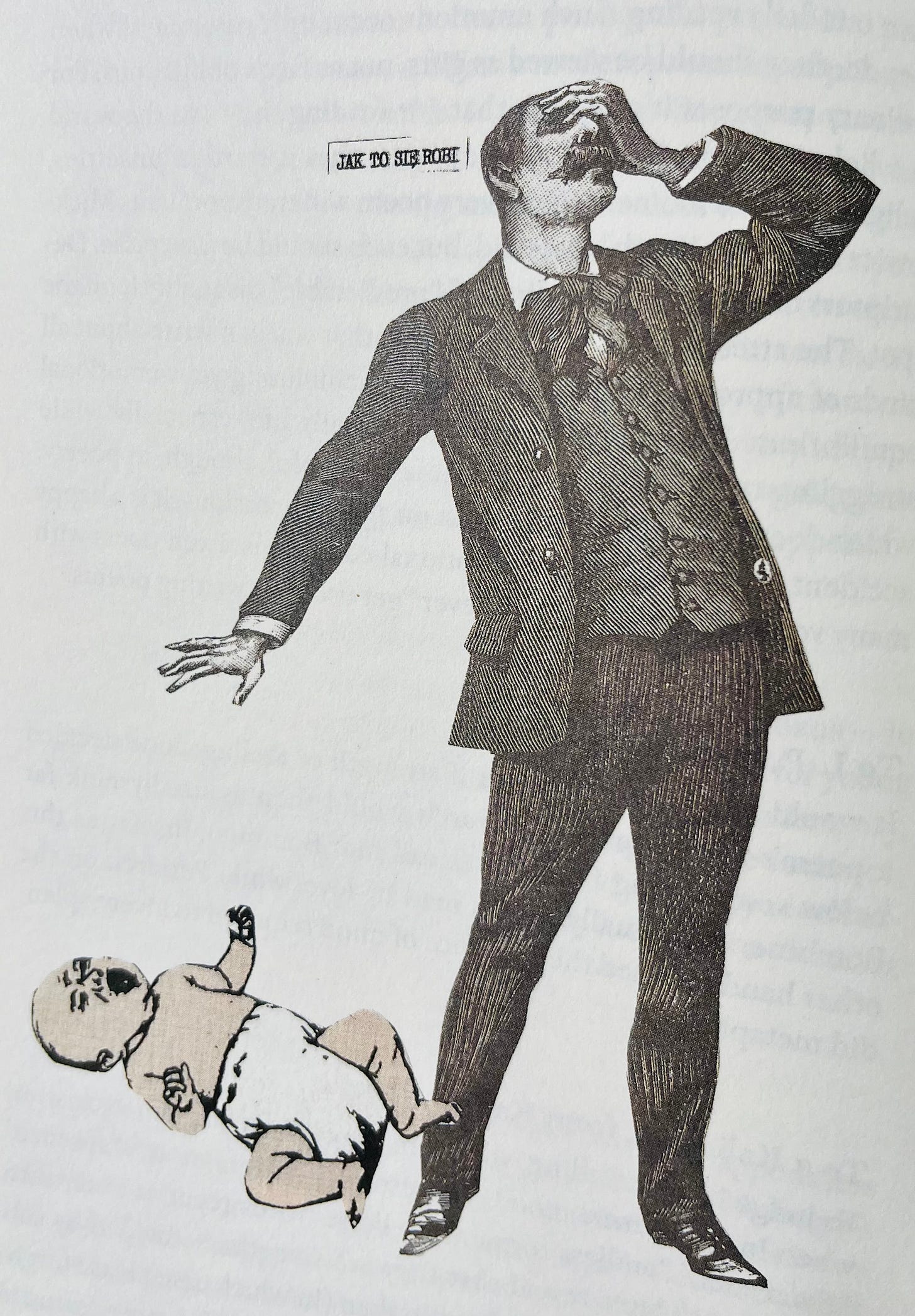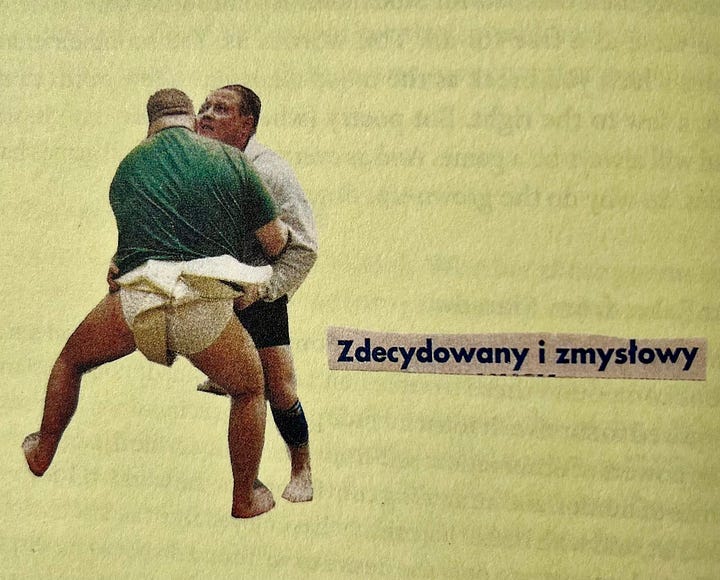& try writing on foot, shall we?
In this post: Writing slow, a Great Horned Cat, and a chance to go postal
Greetings to you in this new year, so fresh it’s like a baby just out of the bath. I hope you are well and feeling hopeful. If you need a break from the current news cycle, please go to the next paragraph. If not, you’re invited to read the first footnote. 1
As I’ve mentioned before, I’m a fan of the Polish poet and essayist Wisława Symborska. She lived through both a German and Soviet occupation, and she won the Nobel Prize for Literature. She wrote one of my favorite poems on the subject of war.2 Since I know her mostly for her poetry, I did not know that she also created brilliant collages. Some of the images are featured in her How to Start Writing and When to Stop: Advice for Authors, a kind of how-to guide composed of pieces from an anonymous advice column for writers. 3 The writing advice Szymborska dishes out is at turns encouraging and withering, (usually a generous portion of the latter if the writer shows up smug or cocky in their letter).

“Let’s take the wings off, and try writing on foot” is a line from the book, and in the forward, translator Clare Cavanagh writes that Szymborska made a point of writing in a painstaking and spare manner, with no fuss or fanciness. I’ve been thinking about what it might mean to “write on foot.” On foot means walking, which means getting to places more slowly. It means elongating the hour with each footfall. Observing the scenery, with time to inspect all the angles of a day. It might mean noticing the pair of shoes looped over a telephone wire above your head, or a faded Missing Cat sign on a splintery telephone pole, (“..answers to Raymond”). Writing on foot might mean writing by hand on a blank piece of graph paper or in a journal or a postcard, slow-like, with as few distractions around you as possible. It might mean reading a poem or a short passage, then sitting without moving while the words settle to the ocean floor inside you. Then beginning to write.

A gray morning in November found me standing stock still in the side yard, trying to record and identify the sounds of the tiny birds flitting about on the dried lemon balm. They were perfect and light, scarcely bending the dry stalks where they landed, and I was so intent on their movements that I was as surprised as they were when Myrtle the cat lunged into the air toward them. They flew all directions as I grabbed her up, tucked her under one arm and deposited her inside the house. When I looked at my Merlin bird app4 to see what it had picked up, the mysterious tiny birds were nowhere to be found. It had captured two others, though: a nearby Chickadee and, incredibly, a Great Horned Owl! But when I listened to the recording of the owl, it sounded suspiciously like the strangled meow of a cat. Myrtle, to be precise. The app had identified Myrtle as a Great Horned Owl. A strange mistake, but to be honest, their coloring is not dissimilar.5 If she perched next to that owl in a tree, they’d look like sisters from a distance.

Back to Szymborska’s collages 6 – I was so happy to discover her art, and it strikes me that collage can offer the same kind of slow-down as “writing on foot” does. This winter I’ve been messing about with scissoring images from old National Geographic magazines, and pasting tiny bird heads into dark suits and ties. Szymborska apparently created a collage postcard each year that she sent out to friends, and man, I wish I lived in a universe where a postcard from her would arrive in my mailbox. But since none of us lives in that world, I think we’d better just do it for ourselves. Which brings us to this month’s Truth & Dare, (see below).


Truth: Slow down and allow yourself a writing session with your wings off. Write by hand, notice what you notice, and don’t be fancy. And when you’re finished, consider crumpling it up and throwing it away. Szymborska apparently tossed 90% of her work in the waste basket. (Probably very liberating, but what gems she must have thrown away).
Dare: Create a collage postcard from old magazines or new, weird ones. Bonus points for lifting one from the waiting room of a doctor’s office. (Simple is good: glue stick, scissors, images). Send your postcard to a person/people. Want to receive a weird bird postcard? Reply in the comments, or send me something to:
Laura Moulton / PO Box 13642 / Portland, OR. 97213
Thank you for reading this far! 7
1 When the U.S. was attacked on 9/11, I was teaching at an international language school in Portland. We had students from all over the world, many from Arab countries. Most of them packed up hastily and flew back to their worried parents, which was an example of one of the small “l” losses that happened to our community as we grieved the larger, more obvious ones in our country. And when George Bush began to announce the run-up to war, (sad shake of his cowboy head, a fatherly “This hurts me more than it hurts you..”), and then we were bombing Afghanistan, I thought, What if instead of dropping bombs on earthen infrastructure and poor people, we first dropped leaflets covered in poetry, and then airdropped poets who were fluent in Dari and Pashto, and any other necessary language? Their assignment would be: Approach With Curiosity. And they’d report back after 30 days.
Poets always make things better.
I remembered this again after I read the New Yorker piece by the poet Mosab Abu Toha, who recently wrote a piece in the New Yorker about his detention by Israelis as his family tried to flee the bombing in Gaza. Barring Toha’s presence there and the account of his experience, we wouldn’t really know what was happening to Palestinians on the ground in Gaza, given the number of journalists killed or wounded, and the periodic black-outs. So I was grateful for his reporting and heartsick at what he and his family experienced, (and they are alive—some 22,000 people are dead as I type this sentence). I know that there are thickety complications to this conflict, and people suffering loss in different places, differently. But just as in the days after 9/11 in the States, I reject the indiscriminate bombing of humans, of babies fresh from the bath, (assuming bathtub, assuming access to water) and diabetic grandmothers and young men studying to be botanists. Of small neat courtyards with chickens and rabbits, and olive and fig trees and grapevines. Donkeys who had names and carried bundles on their backs, and shops selling pastries and cheeses, nuts and dates. I condemn the crushing and rubbling of dreams, and the use of dumb bombs, bunker buster bombs and white phosphorus, (the phrase its own terrible poem) provided in part by the United States and our tax dollars. Stop the bombing. Let people live. Send in the poets.
3 In the Polish journal Literary Life, (where she served on the editorial board from 1953-1981)
4 It’s a cool app for discovering the birds that live in your yard, and learning their names and habits

6 Examples of her cut-and-paste collage postcards
7 For one thing, time is precious and finite and there are plenty of substacks out there, really sharp, funny ones like Chris LaTray’s Irritable Metis and Mindy Nettifee’s In the River of What’s Happening Now and Natalie Serber’s read.write.eat.